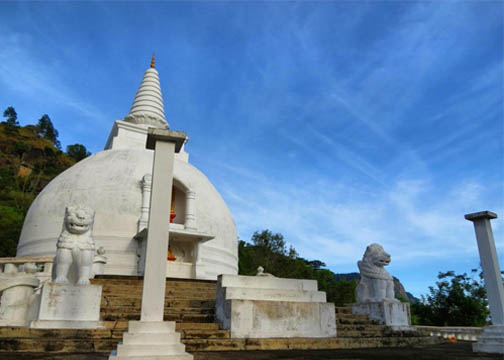Japanese “Peace Pagoda” in Sri Lanka. By Dr.Gamini Kariyawasam.
 Rumassala, known to colonialists as Buona Vista, is the subject of many legends. It is featured in the Ramayana, as the home of the beautiful Queen Sita.
Rumassala, known to colonialists as Buona Vista, is the subject of many legends. It is featured in the Ramayana, as the home of the beautiful Queen Sita.
According to the Ramayana, it is also said that Hanuman dropped a chunk of ‘Himalaya’ at Unawatuna (Onna Vetuna – ‘here it fell’) to form the present mountain, where many medicinal plants still grow. There is a major magnetic anomaly near Unawatuna, which Arthur C. Clarke attributes to a meteorite strike, and it is said that satellites lose their orbits with unusual frequency overhead. The Portuguese had a dreadful reputation in Sri Lanka as looters and pirates, are said to have given false light signals from Rumassala to lure unsuspecting Arab trading ships onto the rocks.
Mythical Legend
According to legend, the Monkey-warrior Hanuman was sent back to India to fetch the four medicinal herbs, mritasanjeevani, vishalyakarani, suvarnakarani from the Himalayas in the mountains to heal Lakshman who was wounded in his great battle with Ravana to save the abducted Princess Sita as he failed to identify the herbs he uprooted the mount and ferried it to the battlefield and a chunk of that “fell-down” forming theRumassala Hillock, and the name of the village derived from Unna-watuna meaning “fell down
How does one reach Rumassala? One has to pass Galle Town from Colombo towards Kataragama and in about 10 minutes a signboard to Rumassala “Rumassala Sama Ceitya” comes into view on the seaside. After five minutes from the signboard on the narrow road, you reach the Sama Ceitya. From this place, we could see the magnificent view of the sea. There’s a beach track from Sama Ceitya to the sea with fully grown trees on either side.
Traveling further past the Peace Pagoda is another temple called Sri Vivekaramaya of Rumassala. The temple contains some interesting structures. One is the image of Hanuman carrying the piece of the Himalaya mountain in its hand. The other is a figure of Maithree Bodhisattva
2. Japanese Peace Pagoda , Sri Padha-
The ‘chetiya’ situated at the foot of Sri Pada is the peace pagoda erected by the Japanese Buddhists to spread the message of peace throughout the world from which begins the arduous climb to the summit of Adams Peak.
After passing the makara thorana, one will come across the Japanese sama dagaba (peace pagoda) and accompanying viharaya known as Gangulathenna. It was built by the famous Japanese Buddhist monk Ven Nichi Fuji in 1976 and is one of the one of the peace pagodas built with Japanese aid. The area of Gangula then also had a large ambalama, a structure that offered shelter in the days of yore to weary pilgrims.
Sri Pada: Symbol of inter-faith Harmony
Sri Pada, popularly known in English as Adam’s Peak, is a conical mountain 7,360 feet above sea level, soaring clear above the surrounding mountain ranges. However, the altitude is no damper to the thousands of pilgrims who climb the mountain in endless procession during this time of year.
It is not only a Buddhist pilgrimage. There are Hindus, Christians, and Muslims too who join the white-clad devotees and brave the chill night mountain air, singing hosannas to the Buddha and the deities, climbing through the dark hours to see the miracle of sunrise from the top of the mountain.
Sri Pada is known as the only mountain in the world considered sacred by the followers of the four major faiths in the world – Buddhists, Hindus, Christians, and Muslims. To Buddhists, the imprint at the summit of the mountain is the hallowed footprint of the Buddha, hence the name “Sri Pada”. To the Hindus, the footprint is that of God Shiva. To the Christians, it is the footprint of St. Thomas, and to Muslims, it is the footprint of Adam, hence “Adam’s Peak”. Another name for the mountain by the Sinhalese is “Samanala Kanda” meaning Butterfly Mountain due to the endless flocks of butterflies that wing their way to the mountain at the start of the season.
According to the Mahavamsa, the Great Chronicle of the island, the first person to ascend the holy mountain Sri Pada was King Vijayabahu I (1058-1114), having come to know that at top of the mountain is seen the footmark of the Buddha. The story goes he had gathered the information from the pious woman Manimekhala.
A more colorful story is that the king had seen, in the early hours of one morning, angels plucking flowers in his garden. When questioned, one of them had said “We are plucking flowers to worship the footmark of the Buddha atop the Samanalakanda.”
The sacred footprint that Dr. John Davy saw in 1817, was ornamented with a single margin of brass and studded with a few gems. These are now not to be seen. He says, “The cavity of the footmark certainly bears a coarse resemblance to the figure of a human foot but much oversized. Whether it is really an impression is not very flattering, if not for its huge size. There are little raised partitions to represent the interstices between the toes, to make it appear a human foot.”
The sacred footprint is now on a stone slab at the center of the mountain summit, on a small plateau. The original footprint is beneath the stone slab and is embedded on a large blue sapphire made for protection of the footprint, by an ancient king of Sri Lanka. History records that many distinguished persons, like Ibn Batuta the Arab traveler, and Marco Polo have climbed Sri Pada.
3- Japanese Peace Pagoda Bandarawela
Peace Pagoda is an enormous shrine, recently restored to become one of the most prominent landmarks in Bandarawela. Buddhist Stupa is worshiped by many tourists including both Localss and foreigns. It is a memorial to titillate peace among people.. It was completed by Niponzan Myohoji monks in 1982.
With many opportunities for tourists who are eager to cycle and walk among the sites, this is a quite relaxing getaway from the busy life pattern.
4 – Japanese Peace Pagoda ,Walapane


The Walapane Peace Pagoda,situated near Kurudu Ella famous waterfall, was built by Nichidatsu Fujhi monk, is located on Walapane, Central Province of Sri Lanka. Fellow sister cities include Ampara, Bandarawela, Galle, and Sri Pada of Sri Lanka. Peace Pagoda is an enormous shrine, recently restored to become one of the most prominent landmarks in Walapane. In addition, Peace pagoda is located on the top of a mountain providing adorable views of a mountain range to the visitors. With many opportunities for tourists who are eager to cycle and walk among the sites, this is a quite relaxing getaway from the busy life patterns.
5- Japanese Peace Pagoda,Ampara
Ampara Peace Pagoda (also known as Ampara Sama Ceitya, is a small town located in the Eastern Province of Sri Lanka and is one of Ampara’s most prominent landmarks. The most peaceful place and Natural,Green. The Ampara Peace Pagoda was constructed by Nipponzan monks under the patronage of Nichidatsu Fujii maha thero (1885-1985) of
Nipponzan-Myōhōji of Japan with the objective of commemorating his 99th birthday. Fujii was greatly inspired by his meeting with Mahatma Gandhi in 1931 and decided to devote his life to promoting non-violence. In 1947. The Pagoda was declared open by Junius Richard ( J.R ) Jayewardene, President of Sri Lanka on 28 February 1988. The Peace Pagoda temple is situated 4 km away from the Ampara DS Senanayake Rd from the clock tower, which heads towards Inginyagala. The temple consists of a Pagoda, a Mahayana-style Vihara geya (Image house), and a small Bodhi tree. The pagoda is retinue with 99 small pagodas and there is a straight path from the entrance to the pagoda.
It’s a must-see place if anyone plans a trip to Ampara. not only a sacred Buddhist temple but also full of beautiful scenic views in a calm and quiet environment.Sometimes if you are lucky you may meet elephants.
Dr.Gamini Kariyawasam.












